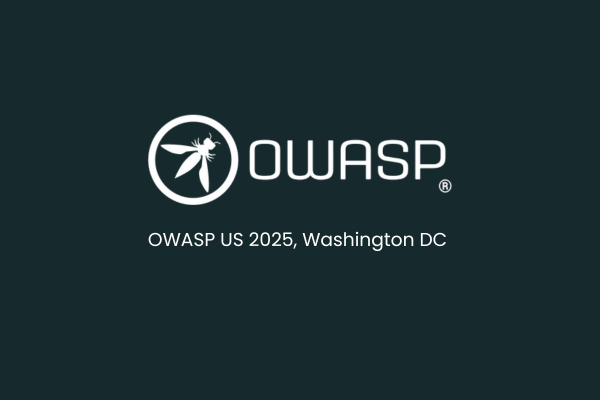The OWASP Global AppSec USA conference, held Nov. 6 and 7 in Washington, D.C., revealed that the future of application security is already here, and it's changing faster than most teams can keep up with.
This year, OWASP announced two major additions to its Top 10 Web Application Security Risks list: Insecure Design and AI-Driven Vulnerabilities. These new categories reflect a reality that many AppSec teams are already living. Software development is no longer just human-driven. It's powered by autonomous systems that write, test, and even deploy code.

According to OWASP, these updates were necessary to capture the fundamental shift in how vulnerabilities emerge when intelligent agents start influencing application logic. The traditional risks like injection flaws or broken authentication have not disappeared, but they're now joined by risks introduced at design time or during AI-assisted code generation.
The Evolving Challenges for AppSec Professionals
At the conference, our conversations centered around how security teams are struggling to adapt to this new landscape.
1. AI-generated code creates new risk surfaces. AI coding assistants now contribute a large share of enterprise code. At leading tech companies, AI already generates close to one-third of new code, and that number is rapidly increasing. The problem is that these models often replicate insecure patterns from open-source repositories. OWASP’s new “AI-Driven Vulnerabilities” category reflects the fact that insecure code can be produced automatically and at scale.
2. Security teams cannot match the velocity of AI-driven development.
While developers are building faster with AI, AppSec teams remain stuck with manual reviews, pull request backlogs, and endless triage cycles. Many AppSec professionals are now overwhelmed by the growing number of AI-generated changes that need review. Without automation, most vulnerabilities go unaddressed until late in the lifecycle, if at all.
3. Governance now matters as much as detection. OWASP’s emphasis on “Insecure Design” highlights that secure architecture decisions can no longer be an afterthought. AppSec professionals must govern how systems and agents behave, not just what code they produce. The community repeatedly emphasized the importance of defining security policies at the point of code generation rather than relying on traditional scanning afterward.
The Emergence of Agentic Security
“AI security” and “agentic security” came up often, and could be found on booth signage and vendor messaging throughout the event. These terms refer to applying security principles to the behavior of autonomous or semi-autonomous systems that act on behalf of humans. These agents are no longer just assistants. They’re active participants in the software development lifecycle and require guardrails and governance just much as any developer.
Traditional application security tools were not built to monitor or control them. They can scan, report, and remediate, but they do not influence how an AI decides to generate or modify code in the first place. That is where agentic security is evolving: embedding security logic at the level of AI reasoning itself.
How Arnie Is Tackling the New OWASP Challenges
For the Arnica team, these OWASP updates validated a direction we have been building toward. Our AI security suite, Arnie, was designed specifically to address the challenges of AI-generated code and agentic development.
Arnie AI SAST combines deterministic static analysis with adaptive AI reasoning. It extends traditional SAST by understanding context and intent. This allows it to detect emerging classes of vulnerabilities such as hidden backdoors or authorization flaws that static rules alone might miss. Because it operates continuously across every push and branch, it finds issues in real time and communicates them directly to developers in their native tools like Slack or Microsoft Teams.
Arnie’s Agentic Rules Enforcer focuses on prevention rather than detection. It automatically injects secure coding instructions into AI coding tools such as GitHub Copilot, Cursor, Claude, and Gemini, ensuring that every AI-generated line of code aligns with OWASP ASVS and corporate security standards. By committing version-controlled rule files like .github/copilot-instructions.md and .cursor/rules across all repositories, Arnie guarantees consistent security enforcement at the moment of code creation.
Together, these capabilities form a multi-agent security suite that protects developers and AppSec teams throughout the lifecycle. Arnie not only analyzes and fixes code but also governs how AI itself behaves.
From Detection to Prevention
The OWASP Top 10 update was more than a list. It was a signal that the age of post-development scanning is ending. Prevention, design governance, and AI oversight are now essential pillars of application security.
Arnie embodies that evolution. By embedding agentic guardrails into AI tools and pairing them with intelligent, context-aware analysis, Arnica helps organizations adopt AI development safely and confidently.
As OWASP recognized, the biggest risk is no longer what a developer might miss. It’s what their AI might create. The future of AppSec, however, is intelligent, proactive, and secure by design.
Reduce Risk and Accelerate Velocity
Integrate Arnica ChatOps with your development workflow to eliminate risks before they ever reach production.


